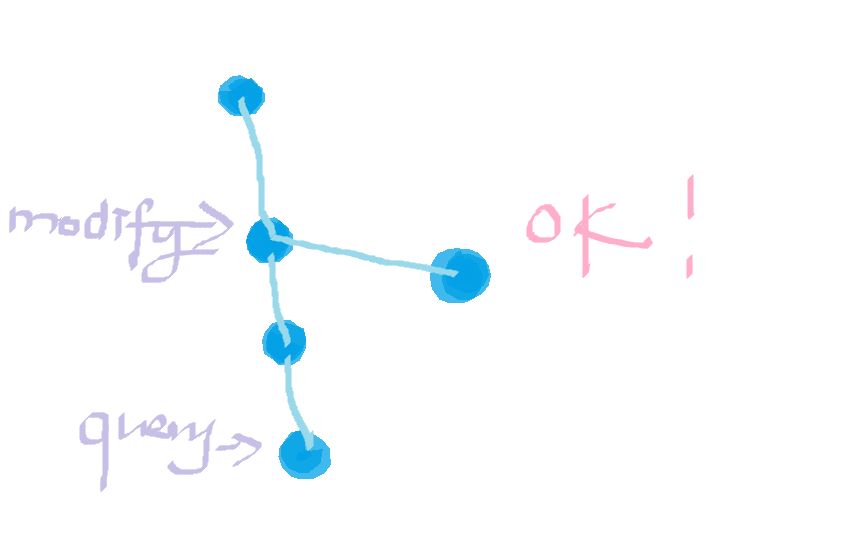Description
有一棵点数为 N 的树,以点 1 为根,且树点有边权。然后有 M 个
操作,分为三种:
操作 1 :把某个节点 x 的点权增加 a 。
操作 2 :把某个节点 x 为根的子树中所有点的点权都增加 a 。
操作 3 :询问某个节点 x 到根的路径中所有点的点权和。
Input
第一行包含两个整数 N, M 。表示点数和操作数。
接下来一行 N 个整数,表示树中节点的初始权值。
接下来 N-1 行每行三个正整数 fr, to , 表示该树中存在一条边 (fr, to) 。
再接下来 M 行,每行分别表示一次操作。其中第一个数表示该操
作的种类( 1-3 ) ,之后接这个操作的参数( x 或者 x a ) 。
Output
对于每个询问操作,输出该询问的答案。答案之间用换行隔开。
Sample Input
5 5
1 2 3 4 5
1 2
1 4
2 3
2 5
3 3
1 2 1
3 5
2 1 2
3 3
Sample Output
6
9
13
嘿 看这种题想法:
哦树剖+线段树
/再见
好吧 然后 dfs序研究了一会 发现 树状数组 貌似可以
然后第一个第三个好说
第二个怎么办?

然后我们发现 只考虑第二个操作 一个点x到根节点的值为
deep位深度,w[i]为 某次第二次操作增加的 值
(deep[x]+1)*sum(w[i)
但是这样是多的。你把 他的干接点之前的也算上了
那就再减去多加的Σ (deep[root[x]])*w[i] 就搞定了
so
三个树状数组 搞定 二维还是结构体随你啦~~
#include<cstdio>
#include<cstring>
#include<algorithm>
#define int long long
using namespace std;
//by mars_ch
long long c[1000005][5];
int in[100005],out[100005],v[100005],dis[100005],time;
int n,m;
struct data
{
int f,t,w,nxt;
} e[1000005*2];
int first[100005],tot;
void add(int a,int b)
{
e[tot].f=a,e[tot].t=b;
e[tot].nxt=first[a];
first[a]=tot++;
}
void dfs(int x,int fa)
{
in[x]=++time;
for(int i=first[x];i!=-1;i=e[i].nxt)
{
int t=e[i].t;
if(t == fa) continue;
dis[t]=dis[x]+1;
dfs(t,x);
}
out[x]=++time;
}
int lowbit(int x)
{
return x&(-x);
}
void updata(int a,int b,int t)
{
while(a<=time)
{
c[a][t]+=b;
a+=lowbit(a);
}
}
long long query(int a,int t)
{
long long res=0;
while(a)
{
res+=c[a][t];
a-=lowbit(a);
}
return res;
}
signed main()
{
scanf("%lld%lld",&n,&m);
memset(first,-1,sizeof(first));
for(int i=1;i<=n;i++)
{
scanf("%lld",&v[i]);
}
for(int i=1;i<=n-1;i++)
{
int a,b;
scanf("%lld%lld",&a,&b);
add(a,b);
add(b,a);
}
dfs(1,0);
for(int i=1;i<=n;i++)
{
updata(in[i],v[i],0);
updata(out[i],-v[i],0);
}
for(int i=1;i<=m;i++)
{
int op;
scanf("%lld",&op);
if(op == 1)
{
int x,y;
scanf("%lld%lld",&x,&y);
updata(in[x],y,0);
updata(out[x],-y,0);
}
if(op == 2)
{
int x,y;
scanf("%lld%lld",&x,&y);
updata(in[x],y,1);
updata(out[x],-y,1);
updata(in[x],1ll*dis[x]*y,2);
updata(out[x],-1ll*dis[x]*y,2);
}
if(op == 3)
{
int x;
scanf("%lld",&x);
long long ans=query(in[x],0)+query(in[x],1)*1ll*(dis[x]+1)-query(in[x],2);
printf("%lld\n",ans);
}
}
return 0;
}


























 384
384

 被折叠的 条评论
为什么被折叠?
被折叠的 条评论
为什么被折叠?








